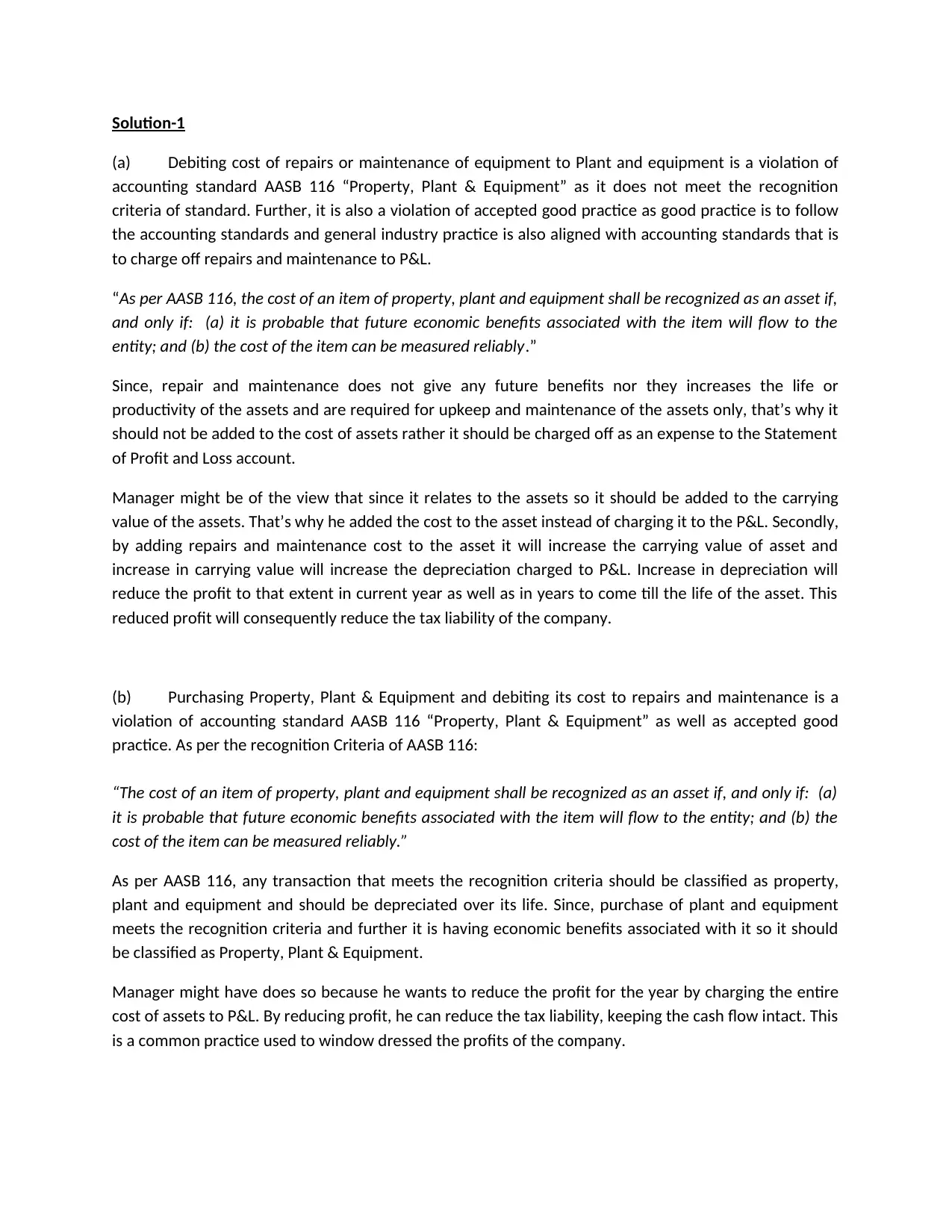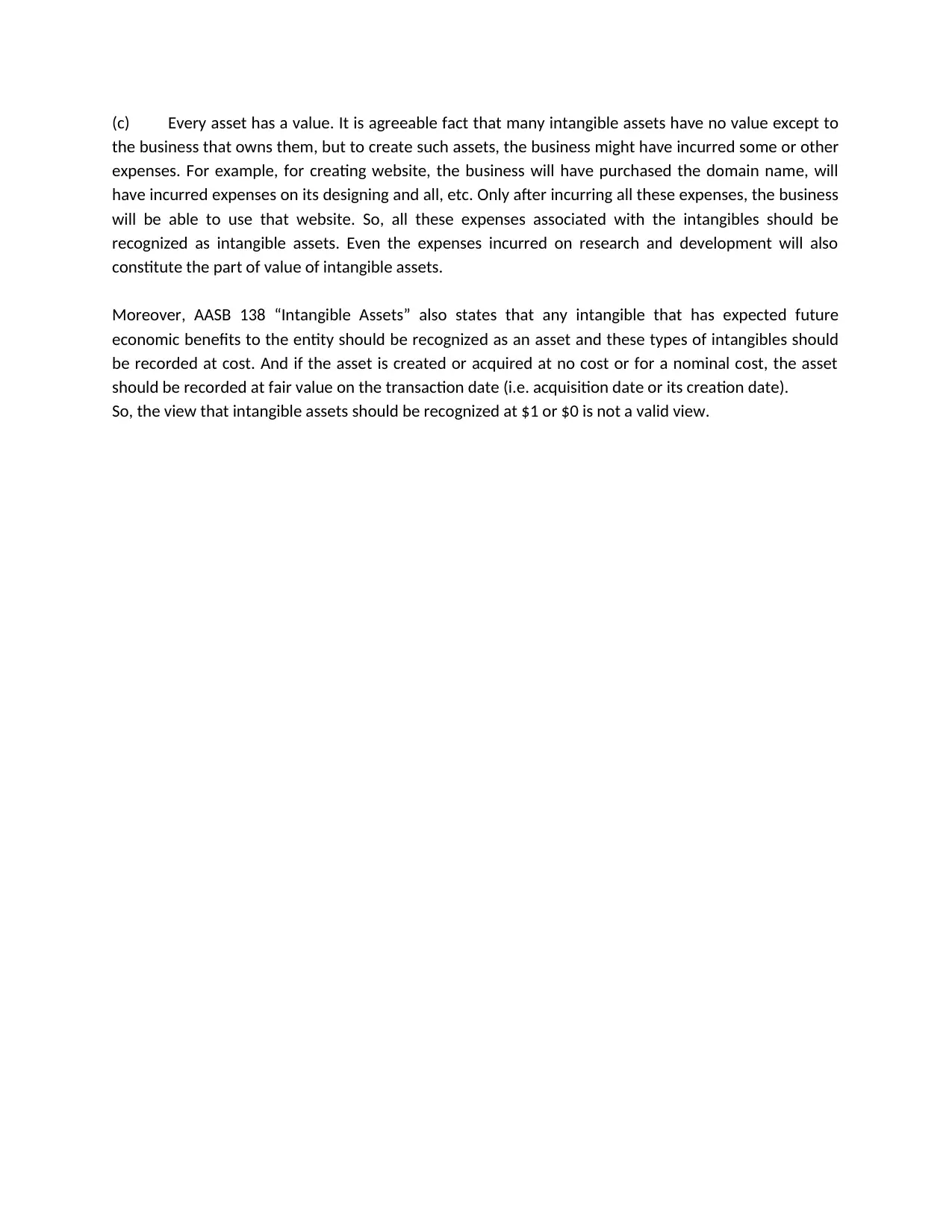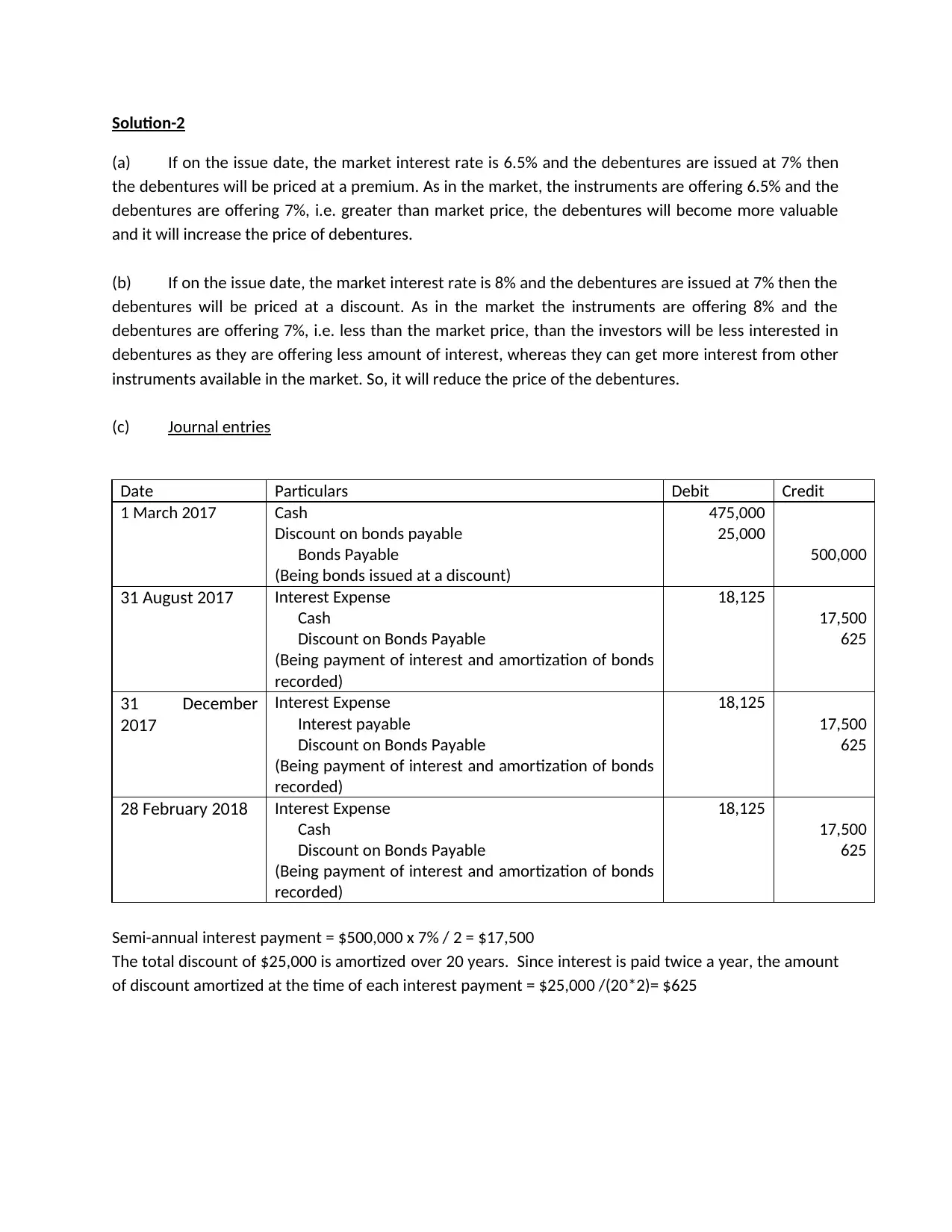Analysis of Accounting Standard Violations in Financial Reporting
VerifiedAdded on 2020/03/02
|3
|1106
|127
Homework Assignment
AI Summary
This assignment presents two solutions addressing violations of accounting standards and financial instruments. Solution 1 focuses on AASB 116, highlighting the incorrect treatment of repair and maintenance costs and the purchase of property, plant, and equipment. It explains why these costs should not be added to asset values, detailing the impact on depreciation, profit, and tax liability. It also addresses the proper recognition of intangible assets. Solution 2 deals with debentures, explaining how market interest rates influence their pricing (premium or discount). It provides journal entries for bond issuance at a discount, including interest payments and amortization, and calculates semi-annual interest. The solutions offer a comprehensive analysis of accounting principles and their application in financial reporting, providing valuable insights for students and professionals.

Solution-1
(a) Debiting cost of repairs or maintenance of equipment to Plant and equipment is a violation of
accounting standard AASB 116 “Property, Plant & Equipment” as it does not meet the recognition
criteria of standard. Further, it is also a violation of accepted good practice as good practice is to follow
the accounting standards and general industry practice is also aligned with accounting standards that is
to charge off repairs and maintenance to P&L.
“As per AASB 116, the cost of an item of property, plant and equipment shall be recognized as an asset if,
and only if: (a) it is probable that future economic benefits associated with the item will flow to the
entity; and (b) the cost of the item can be measured reliably.”
Since, repair and maintenance does not give any future benefits nor they increases the life or
productivity of the assets and are required for upkeep and maintenance of the assets only, that’s why it
should not be added to the cost of assets rather it should be charged off as an expense to the Statement
of Profit and Loss account.
Manager might be of the view that since it relates to the assets so it should be added to the carrying
value of the assets. That’s why he added the cost to the asset instead of charging it to the P&L. Secondly,
by adding repairs and maintenance cost to the asset it will increase the carrying value of asset and
increase in carrying value will increase the depreciation charged to P&L. Increase in depreciation will
reduce the profit to that extent in current year as well as in years to come till the life of the asset. This
reduced profit will consequently reduce the tax liability of the company.
(b) Purchasing Property, Plant & Equipment and debiting its cost to repairs and maintenance is a
violation of accounting standard AASB 116 “Property, Plant & Equipment” as well as accepted good
practice. As per the recognition Criteria of AASB 116:
“The cost of an item of property, plant and equipment shall be recognized as an asset if, and only if: (a)
it is probable that future economic benefits associated with the item will flow to the entity; and (b) the
cost of the item can be measured reliably.”
As per AASB 116, any transaction that meets the recognition criteria should be classified as property,
plant and equipment and should be depreciated over its life. Since, purchase of plant and equipment
meets the recognition criteria and further it is having economic benefits associated with it so it should
be classified as Property, Plant & Equipment.
Manager might have does so because he wants to reduce the profit for the year by charging the entire
cost of assets to P&L. By reducing profit, he can reduce the tax liability, keeping the cash flow intact. This
is a common practice used to window dressed the profits of the company.
(a) Debiting cost of repairs or maintenance of equipment to Plant and equipment is a violation of
accounting standard AASB 116 “Property, Plant & Equipment” as it does not meet the recognition
criteria of standard. Further, it is also a violation of accepted good practice as good practice is to follow
the accounting standards and general industry practice is also aligned with accounting standards that is
to charge off repairs and maintenance to P&L.
“As per AASB 116, the cost of an item of property, plant and equipment shall be recognized as an asset if,
and only if: (a) it is probable that future economic benefits associated with the item will flow to the
entity; and (b) the cost of the item can be measured reliably.”
Since, repair and maintenance does not give any future benefits nor they increases the life or
productivity of the assets and are required for upkeep and maintenance of the assets only, that’s why it
should not be added to the cost of assets rather it should be charged off as an expense to the Statement
of Profit and Loss account.
Manager might be of the view that since it relates to the assets so it should be added to the carrying
value of the assets. That’s why he added the cost to the asset instead of charging it to the P&L. Secondly,
by adding repairs and maintenance cost to the asset it will increase the carrying value of asset and
increase in carrying value will increase the depreciation charged to P&L. Increase in depreciation will
reduce the profit to that extent in current year as well as in years to come till the life of the asset. This
reduced profit will consequently reduce the tax liability of the company.
(b) Purchasing Property, Plant & Equipment and debiting its cost to repairs and maintenance is a
violation of accounting standard AASB 116 “Property, Plant & Equipment” as well as accepted good
practice. As per the recognition Criteria of AASB 116:
“The cost of an item of property, plant and equipment shall be recognized as an asset if, and only if: (a)
it is probable that future economic benefits associated with the item will flow to the entity; and (b) the
cost of the item can be measured reliably.”
As per AASB 116, any transaction that meets the recognition criteria should be classified as property,
plant and equipment and should be depreciated over its life. Since, purchase of plant and equipment
meets the recognition criteria and further it is having economic benefits associated with it so it should
be classified as Property, Plant & Equipment.
Manager might have does so because he wants to reduce the profit for the year by charging the entire
cost of assets to P&L. By reducing profit, he can reduce the tax liability, keeping the cash flow intact. This
is a common practice used to window dressed the profits of the company.
Paraphrase This Document
Need a fresh take? Get an instant paraphrase of this document with our AI Paraphraser

(c) Every asset has a value. It is agreeable fact that many intangible assets have no value except to
the business that owns them, but to create such assets, the business might have incurred some or other
expenses. For example, for creating website, the business will have purchased the domain name, will
have incurred expenses on its designing and all, etc. Only after incurring all these expenses, the business
will be able to use that website. So, all these expenses associated with the intangibles should be
recognized as intangible assets. Even the expenses incurred on research and development will also
constitute the part of value of intangible assets.
Moreover, AASB 138 “Intangible Assets” also states that any intangible that has expected future
economic benefits to the entity should be recognized as an asset and these types of intangibles should
be recorded at cost. And if the asset is created or acquired at no cost or for a nominal cost, the asset
should be recorded at fair value on the transaction date (i.e. acquisition date or its creation date).
So, the view that intangible assets should be recognized at $1 or $0 is not a valid view.
the business that owns them, but to create such assets, the business might have incurred some or other
expenses. For example, for creating website, the business will have purchased the domain name, will
have incurred expenses on its designing and all, etc. Only after incurring all these expenses, the business
will be able to use that website. So, all these expenses associated with the intangibles should be
recognized as intangible assets. Even the expenses incurred on research and development will also
constitute the part of value of intangible assets.
Moreover, AASB 138 “Intangible Assets” also states that any intangible that has expected future
economic benefits to the entity should be recognized as an asset and these types of intangibles should
be recorded at cost. And if the asset is created or acquired at no cost or for a nominal cost, the asset
should be recorded at fair value on the transaction date (i.e. acquisition date or its creation date).
So, the view that intangible assets should be recognized at $1 or $0 is not a valid view.

Solution-2
(a) If on the issue date, the market interest rate is 6.5% and the debentures are issued at 7% then
the debentures will be priced at a premium. As in the market, the instruments are offering 6.5% and the
debentures are offering 7%, i.e. greater than market price, the debentures will become more valuable
and it will increase the price of debentures.
(b) If on the issue date, the market interest rate is 8% and the debentures are issued at 7% then the
debentures will be priced at a discount. As in the market the instruments are offering 8% and the
debentures are offering 7%, i.e. less than the market price, than the investors will be less interested in
debentures as they are offering less amount of interest, whereas they can get more interest from other
instruments available in the market. So, it will reduce the price of the debentures.
(c) Journal entries
Date Particulars Debit Credit
1 March 2017 Cash
Discount on bonds payable
Bonds Payable
(Being bonds issued at a discount)
475,000
25,000
500,000
31 August 2017 Interest Expense
Cash
Discount on Bonds Payable
(Being payment of interest and amortization of bonds
recorded)
18,125
17,500
625
31 December
2017
Interest Expense
Interest payable
Discount on Bonds Payable
(Being payment of interest and amortization of bonds
recorded)
18,125
17,500
625
28 February 2018 Interest Expense
Cash
Discount on Bonds Payable
(Being payment of interest and amortization of bonds
recorded)
18,125
17,500
625
Semi-annual interest payment = $500,000 x 7% / 2 = $17,500
The total discount of $25,000 is amortized over 20 years. Since interest is paid twice a year, the amount
of discount amortized at the time of each interest payment = $25,000 /(20*2)= $625
(a) If on the issue date, the market interest rate is 6.5% and the debentures are issued at 7% then
the debentures will be priced at a premium. As in the market, the instruments are offering 6.5% and the
debentures are offering 7%, i.e. greater than market price, the debentures will become more valuable
and it will increase the price of debentures.
(b) If on the issue date, the market interest rate is 8% and the debentures are issued at 7% then the
debentures will be priced at a discount. As in the market the instruments are offering 8% and the
debentures are offering 7%, i.e. less than the market price, than the investors will be less interested in
debentures as they are offering less amount of interest, whereas they can get more interest from other
instruments available in the market. So, it will reduce the price of the debentures.
(c) Journal entries
Date Particulars Debit Credit
1 March 2017 Cash
Discount on bonds payable
Bonds Payable
(Being bonds issued at a discount)
475,000
25,000
500,000
31 August 2017 Interest Expense
Cash
Discount on Bonds Payable
(Being payment of interest and amortization of bonds
recorded)
18,125
17,500
625
31 December
2017
Interest Expense
Interest payable
Discount on Bonds Payable
(Being payment of interest and amortization of bonds
recorded)
18,125
17,500
625
28 February 2018 Interest Expense
Cash
Discount on Bonds Payable
(Being payment of interest and amortization of bonds
recorded)
18,125
17,500
625
Semi-annual interest payment = $500,000 x 7% / 2 = $17,500
The total discount of $25,000 is amortized over 20 years. Since interest is paid twice a year, the amount
of discount amortized at the time of each interest payment = $25,000 /(20*2)= $625
⊘ This is a preview!⊘
Do you want full access?
Subscribe today to unlock all pages.

Trusted by 1+ million students worldwide
1 out of 3
Related Documents
Your All-in-One AI-Powered Toolkit for Academic Success.
+13062052269
info@desklib.com
Available 24*7 on WhatsApp / Email
![[object Object]](/_next/static/media/star-bottom.7253800d.svg)
Unlock your academic potential
Copyright © 2020–2025 A2Z Services. All Rights Reserved. Developed and managed by ZUCOL.





